55 Years Ago: Apollo AS-202, Final Test Flight Before Planned First Crew Mission
In 1966, to meet President John F. Kennedy’s goal of landing a man on the Moon before the end of the decade, NASA flew five crewed Gemini missions to demonstrate the techniques needed for the lunar-landing mission. In parallel, NASA carried out uncrewed tests of the Apollo spacecraft and the Saturn rockets required to send humans to the Moon and return them safely to Earth. These included three flights of the Saturn IB rocket — AS-201 in February, AS-203 in July, and AS-202 in August — and the rollout to the launch pad of the first Saturn V test vehicle. The AS-202 mission, the third flight of the Saturn IB rocket, launched a fully operational Apollo spacecraft on a 90-minute suborbital mission to test the Command Module’s (CM’s) heat shield and life-support systems and the Service Module’s (SM’s) power-generating fuel cells and main engine. Following the success of these test missions, NASA decided that the next Saturn IB rocket and Apollo spacecraft would carry a crew on an Earth orbital mission.
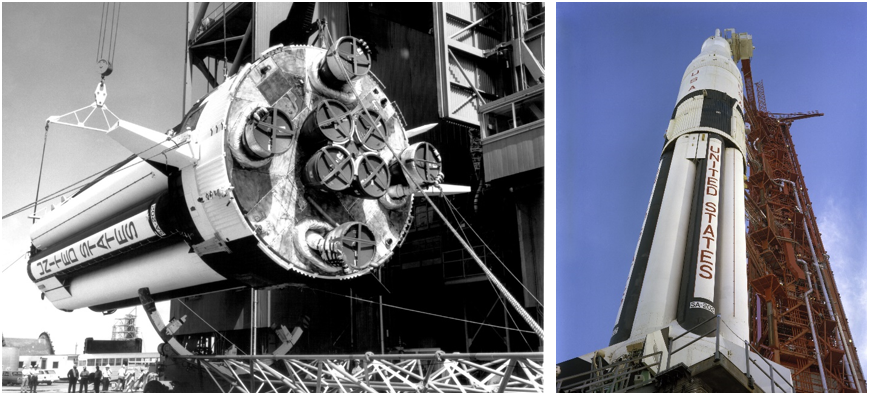
Left: Ground crews hoist the Saturn IB rocket’s first stage for the Apollo AS-202 mission into position at Launch Pad 34 at the Cape Kennedy Air Force Station, now Cape Canaveral Space Force Station, in Florida. Right: The fully stacked Saturn IB for the Apollo AS-202 mission standing on Launch Pad 34 during the countdown demonstration test. Credits: NASA
Components of the Saturn IB rocket for the Apollo AS-202 mission began arriving at the Cape Kennedy Air Force Station in Florida, now the Cape Canaveral Space Force Station, in January 1966. Workers at Launch Pad 34 erected the first stage on March 4, just six days after the launch of the Apollo AS-201 mission from that very same pad. They added the second stage on March 10. For the next month, engineers put the rocket through a series of tests to prepare it for launch.
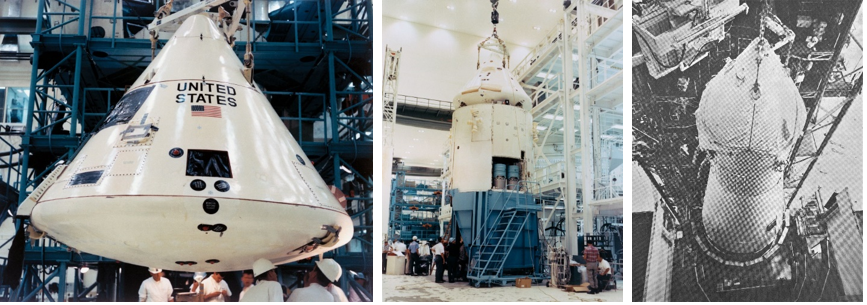
Left: Apollo Command Module-011 (CM-011) shortly after its arrival in the Manned Spacecraft Operations Building (MSOB) at NASA’s Kennedy Space Center in Florida. Middle: In the MSOB, workers mate the Apollo CM-011 to its Service Module, with its two blue-painted fuel cells visible. Right: Workers at Launch Pad 34 at Cape Kennedy Air Force Station stack the Apollo spacecraft atop the Saturn IB rocket. Credits: NASA
The Apollo spacecraft, serial number 011, arrived at the Manned Spacecraft Operations Building at NASA’s Kennedy Space Center in April 1966. The CM’s configuration was nearly identical to one that could carry a crew, including a fully functioning life-support system. The major significant difference was that CM-011 did not incorporate crew couches. The two power-generating fuel cells in the SM would be completing their first in-space tests, and the critical multiple restart capability of the Service Propulsion System (SPS) main engine would be demonstrated. Following vacuum chamber and other testing, on July 2 ground crews transported the spacecraft to Launch Pad 34 and stacked it on top of the Saturn IB rocket. A countdown demonstration on Aug. 8 verified the readiness for launch of both rocket and spacecraft.
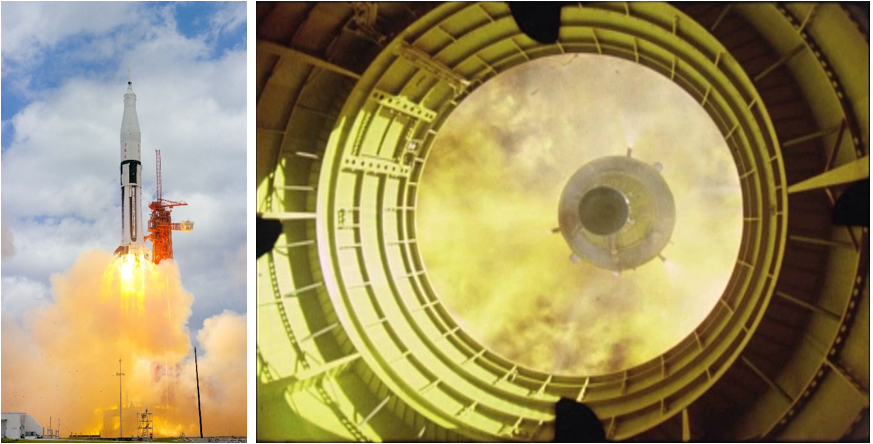
Left: Liftoff of Apollo AS-202 from Launch Pad 34 at the Cape Kennedy Air Force Station. Right: Still image from a film recorded by a recoverable camera in the Saturn IB rocket’s first stage of the second stage separation and ignition of its engine. Credits: NASA
Liftoff of the Apollo AS-202 mission took place on the afternoon of Aug. 25, 1966. The eight H-1 engines of the Saturn IB’s first stage lifted the 225-foot-tall rocket from Launch Pad 34. As soon as the rocket cleared the launch tower, a team of controllers led by Flight Director John D. Hodge in the Mission Control Center at the Manned Spacecraft Center in Houston, now NASA’s Johnson Space Center, took over management of the AS-202 flight. The first-stage engines burned for a little more than two minutes, lifting the rocket to an altitude of 36 miles. The second stage separated and lit its engine, the activity captured on film by two ejectable and recoverable camera pods positioned in the top of the first stage. After another seven-and-a-half minutes, at an altitude of 138 miles, the second stage engine shut down and the Apollo spacecraft separated. Eleven seconds later, the SM’s SPS engine ignited and burned for a little more than three-and-a-half minutes, lifting the spacecraft to its peak altitude of 710 miles about 41 minutes after launch and ensuring a splashdown in the Pacific Ocean. After the spacecraft began its descent back toward Earth, the SPS engine restarted again for 90 seconds to increase its re-entry velocity as part of the heat shield test. Two more brief burns of the SPS engine demonstrated its multiple restart capability.
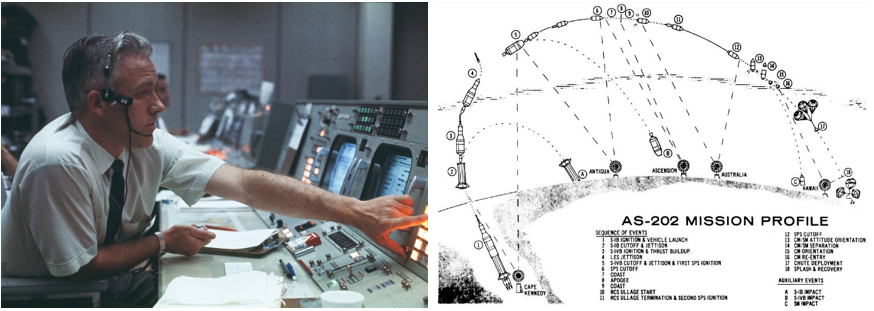
Left: Flight Director John D. Hodge monitors the progress of the Apollo AS-202 flight from the Mission Control Center at the Manned Spacecraft Center in Houston. Right: Schematic representation of the Apollo AS-202 flight profile. Credits: NASA
One hour and 11 minutes after liftoff, the CM separated from the SM and turned its heat shield in the direction of flight to prepare for re-entry. At an altitude of 400,000 feet, or about 75 miles, the capsule encountered the first traces of the Earth’s atmosphere at a velocity of 19,440 mph. The CM’s guidance system steered it through a double-skip re-entry, first descending to an altitude of about 40 miles and then using the capsule’s lift capability to rise back to nearly 50 miles before continuing the final descent — reducing physical loads on the capsule. The heat shield reached a temperature of about 1,500 degress Celsius, while the cabin interior never exceeded 21 degrees Celsius. At 24,000 feet, two drogue parachutes deployed to stabilize and slow the spacecraft, followed by the three main parachutes at 10,000 feet. Splashdown occurred in the Pacific Ocean southeast of Wake Island after a flight of one hour and 33 minutes. The splashdown point was 235 miles short of the targeted area, later determined to be caused by the CM’s lower than predicted lift-to-drag ratio. It took the prime recovery ship U.S.S. Hornet (CV-12) eight-and-a-half hours to reach the capsule and execute the retrieval.
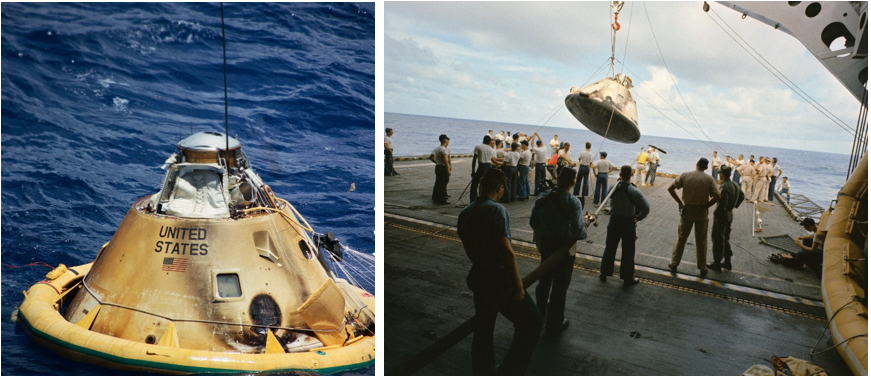
Left: The Apollo Command Module 011 (CM-011) following splashdown in the Pacific Ocean. Right: Recovery teams lifting CM-011 aboard the prime recovery ship U.S.S. Hornet. Credits: NASA
Following the recovery, the Hornet transported CM-011 to the Long Beach Naval Station in California, arriving there on Sept. 2, where workers offloaded it to a portside hangar to drain the vehicle of hazardous propellants. On Sept. 7, CM-011 was transported by truck to its manufacturer, the North American Aviation plant in Downey, California, for postflight testing and analysis.
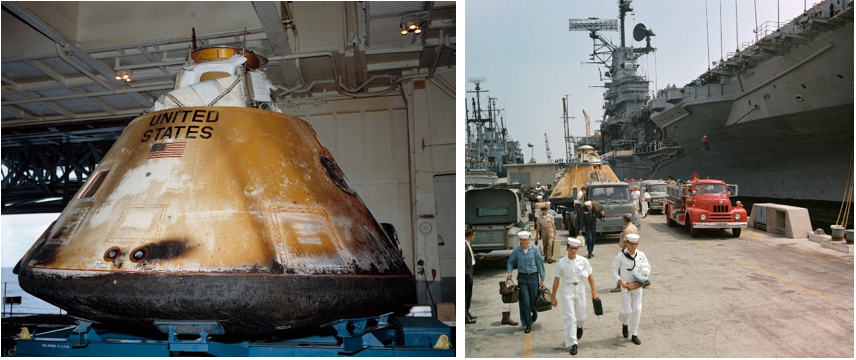
Left: The Apollo AS-202 Command Module-011 (CM-011) aboard the U.S.S. Hornet following recovery from the Pacific Ocean. Right: The CM-011 after being unloaded from the U.S.S. Hornet at Long Beach Naval Station in California. Credits: NASA
Following postflight inspections, CM-011 returned to the Manned Spacecraft Center, for its work was not yet complete. The spacecraft featured prominently in the U.S. pavilion at the World Expo in Montreal between April and October 1967. After going back to the Manned Spacecraft Center, engineers modified it to conduct a drop test on Oct. 31, 1968, to determine whether a space-flown Apollo spacecraft could survive a landing on land, as might be required in an emergency. The capsule, redesignated CM-011A, was dropped at a 23-degree angle, resulting in a crack at the base of the capsule. In the 1970s, NASA turned the spacecraft over to the Smithsonian Institution’s National Air and Space Museum in Washington, D.C., where it was temporarily on exhibit in 2002. In June 2004, CM-011A was trucked for display at the U.S.S. Hornet Sea, Air, and Space Museum in Alameda, California, also where technicians restored the capsule to its post drop test condition.

Left: The Apollo CM-011 on display in the U.S. Pavilion at the Montreal Expo in 1967. Credit: Image courtesy of the Dan Beaumont Space Museum. Middle: The CM-011A during a land impact test at the Manned Spacecraft Center in October 1968. Credits: NASA. Right: The refurbished CM-011A on display at the U.S.S. Hornet Sea, Air, and Space Museum in Alameda, California. Credits: Image courtesy of the U.S.S. Hornet Sea, Air, and Space Museum.
On Oct. 19, 1966, following the three successful Saturn IB missions, two of which included operational Apollo spacecraft, NASA announced that the next flight, AS-204 using spacecraft 012, would be the first Apollo to carry a crew on an Earth orbital mission. The agency assigned astronauts Virgil I. Grissom, command pilot, Edward H. White, senior pilot, and Roger B. Chaffee, pilot, as the prime crew for the flight, which would last as long as 14 days. The backup crew consisted of astronauts James A. McDivitt, David R. Scott, and Russell L. Schweickart. Although no launch date was announced, it was expected to occur in February 1967. Those plans changed tragically on Jan. 27, 1967.

The astronauts selected for the first crewed Apollo mission. Front row: The prime crew of Edward H. White, left, Virgil I. Grissom, and Roger B. Chaffee. Back row: The backup crew of David R. Scott, James A. McDivitt, and Russell L. Schweickart. Credits: NASA
To be continued …







